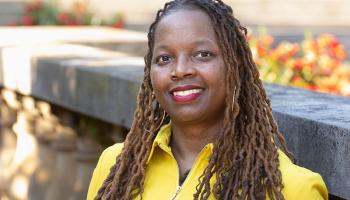What Architecture Can Teach Us about Reading a Poem

Writing about music is like dancing about architecture, according to an old jab at music critics, but could thinking like an architect teach us something about reading poetry? According to Elizabeth Fowler, a professor of English with UVA’s College and Graduate School of Arts & Sciences, it could.
Fowler found that the approaches critics take toward reading poetry weren’t helping her students to explain how poems worked for them. Her solution was to propose a new way of talking about the experience of reading a poem and how language creates that experience.
“When critics talk about poetry we tend to talk about the internal structure of poems or to talk about literary history or allusions to sources or politics, but we don’t have much language to describe exactly how poems interact with readers,” said Fowler, who is both a literary scholar and an architect. “I wanted to put that at the forefront. Most of what we write about when we write about poems is not what people experience when they’re reading them, and it’s not what authors think about when they’re writing them either.”
When she began showing her students similarities between the way we can talk about poems and the way we can talk about buildings, Fowler said, “That’s when the lightbulbs went on.”
In her new book, Poetry and the Built Environment: A Theory of the Flesh of Art, Fowler makes the case that in the same way an architect designs a building to show visitors how to move around inside it, a poet builds a poem to place readers in space and time and in relation to objects and ideas in a way that creates meaning.
The Poet as Yoga Instructor
Yoga offers another unexpected entry way to appreciating poetry, Fowler said. One key to understanding a poem, according to Fowler, is to understand how the poet is inviting readers to move physically.
“Our bodies learn, and we learn as people, how to get around in our built environment. Poems, even though they’re texts and don’t seem to be built artifacts in the same way, tap into our expert ability to sense where our bodies are in space and how they’re moving,” Fowler said.
“Every image in a poem encodes a position from which you are looking at the image,” she continued. “If I describe the inside of a tulip, you have to be close to the tulip to see that. The image moves you closer. If I describe stars, you know that you’re far away and looking up.”
Poetry and the Built Environment offers numerous examples of Fowler’s new way of seeing poetry, including a close reading of Seamus Heaney’s poem “The Wishing Tree,” which explores how Heaney uses the death of a wishing tree – finally overwhelmed by the objects and wishes that have been pinned and nailed to it – to represent the loss of his wife’s mother.
The power of the poem comes from how the poet, much like a yoga instructor, asks his reader to move through the poem’s images, Fowler said. As we read, we imaginatively move between an intimate posture (looking closely at the coins and nails hammered into the tree) to one of distant reverence and awe (seeing the tree magically ascend like a comet in the heavens).
“The poem provides readers with a movement from grief to wonder, and it’s offering that as a kind of script, showing us how we can get there,” Fowler said.
Fowler’s mode of observing art does not invalidate other ways of reading, she said, but it invites critics to develop an expertise in an important but neglected aspect of the reader’s experience.
Recognizing that a poem is written in iambic pentameter can be one way of approaching it, Fowler said. “But I’m more interested in what iambic pentameter does to us, and I don’t think we critics are always very good at explaining that.”
Ultimately, Fowler wants to be able to account for how poems engage us. “In the end, most criticism is not about how fiction and poetry do that, and if we’re not describing what most readers read for, we’re missing something important” she said.
"Our faculty’s commitment to groundbreaking scholarship in the arts and humanities is clearly evident is in this new work," said Christa Acampora, Buckner W. Clay Professor of Philosophy and Dean of Arts & Sciences. "Professor Fowler’s book opens new avenues for understanding how literature engages us, demonstrating how art transforms our view of the world. We’re grateful for her expertise and the inspiration she brings to the University of Virginia."







